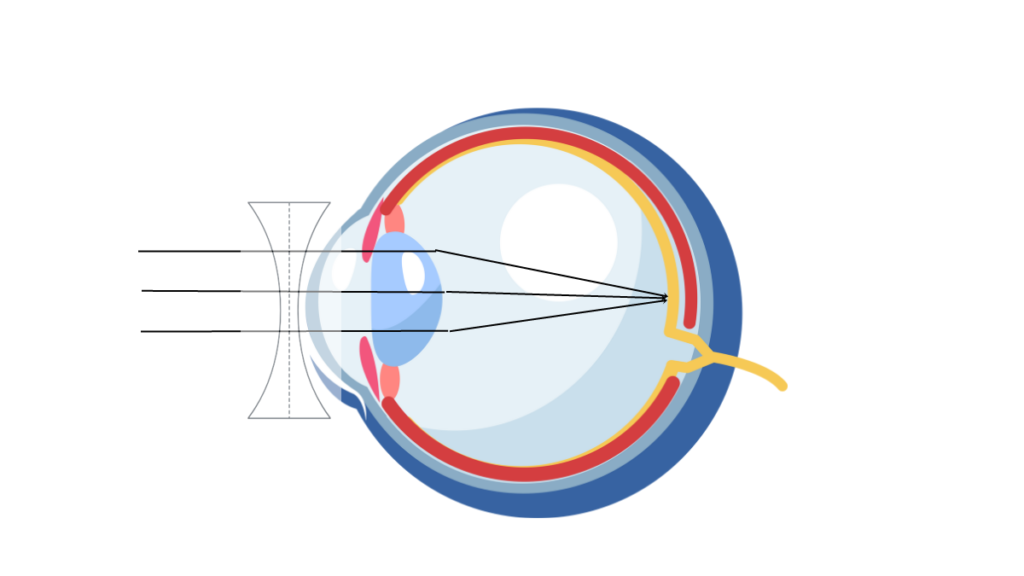Collect the different types of lenses used for correcting eye defects and write a report.
The human eye functions on the principle of sensation of vision. We see objects because the light scattered from them falls on the eye. The eye has a lens in its structure.
3 Common Defects of Vision
Sometimes the eye may gradually lose its ability for accommodation. In such conditions, the person cannot see an object clearly and comfortably. The vision becomes blurred due to accommodation defects of the eye lens. There are three common defects of vision. They are
- Myopia
- Hypermetropia
- Presbyopia
Types of Lenses Used to Correct Vision Defects
The following lenses were used to correct the above defects respectively
- Concave Lens
- Bi-Convex Lens
- Bi-Focal Lens
Let’s dig deep into the eye defects and how we can use these lenses to correct those eye defects.
How Concave Lens is used to Correct Myopia?
1. Myopia is also called nearsightedness. In this people cannot see objects at long distances. But they can see near objects clearly.
2. For these people the maximum focal length is less than 2.5 cm. In such cases, the rays coming from distant objects, after refraction through the eye lens, form an image before the retina.

Far Point: The point of maximum distance at which the eye lens can form an image on the retina is called a far point.
The defect, in which people cannot see objects beyond a far point is called Myopia.
Concave Lens Correcting Myopia
The eye lens can form a clear image on the retina when an object is placed between the far point and the point of least distance of distinct vision.
If we are able to bring the image of the object kept beyond the far point, between the far point and the point of least distance distinct vision using a lens, this image acts as an object for the eye lens.
This can be made possible only when a concave lens is used.

To correct one’s Myopia, we need to select a lens which forms an image at the far point of an object at infinity. We need to select a bi-concave lens to achieve this.
This image acts like an object for the eye lens. Hence the final image is formed on the retina.
How Bi-Convex Lens is Used to Correct Hypermetropia?
Hypermetropia is also known as far-sightedness. A person with hypermetropia can see distant objects clearly but cannot see objects at near distances.
In such cases, rays coming from a nearby object, after refraction at the eye lens, form an image beyond the retina.

Near Point: The point of minimum distance at which the eye lens can form an image on the retina is called near point.
The people with a defect of hypermetropia cannot see objects placed between near point and point of least distance of distinct vision.
Bi-Convex Lens Correcting Hypermetropia
The eye lens can form a clear image on the retina when any object is placed beyond the near point. To Correct the defect of Hypermetropia, we need to use a lens which forms an image of an object beyond a near point, when the object is between a near point and the least distance of distinct vision.
This is possible only when a double convex lens is used.
The image formed by a bi-convex(double convex) lens acts like an object for the eye lens. Hence the final image due to the eye is formed at the retina.
How Bi-Focal Lens is Used to Correct Presbyopia
Presbyopia is a vision defect when the ability of “accommodation of the eye” usually decreases with ageing. For most people the near point gradually recedes away. They find it difficult to see nearby objects clearly and distinctly.
This happens due to the gradual weakening of ciliary muscles and diminishing flexibility of the eye lens. This effect can be seen in aged people.
Sometimes a person may suffer from both myopia and hypermetropia with ageing.
To correct this type of vision we need bi-focal lenses which are formed using both concave and convex lenses. Its upper portion consists of the concave lens and the lower portion consists of the convex lens.
Suggested Projects:
- History Of Spherical Mirrors
- Corrosion of Iron
- Current Carrying Wires Produces Magnetic Fields
- Scientists who developed atomic theories
- Why do alcohols and glucose contain hydrogen but are not categorized as acids
- Experiment to Find Out Focal Length of a Lens
- Water of Crystallization Activity
- How do you select a good place to plant a tree?
- Experiment to find refractive index of Prism
This experiment has been taken from the class 10th Physics textbook
